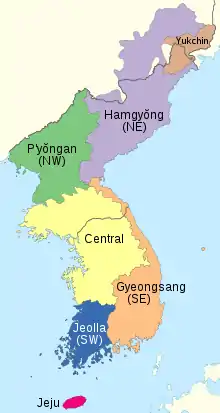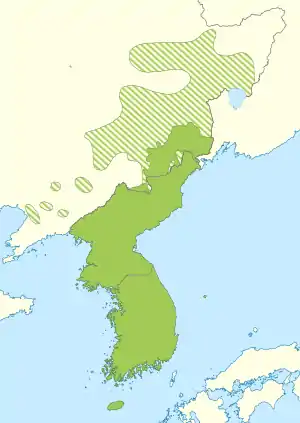Korean dialects
A number of Korean dialects are spoken on the Korean Peninsula. The peninsula is extremely mountainous and each dialect's "territory" corresponds closely to the natural boundaries between different geographical regions of Korea. Most of the dialects are named for one of the traditional Eight Provinces of Korea. One is sufficiently distinct from the others to be considered a separate language, the Jeju language.
| Korean | |
|---|---|
Native speakers | 76 million (2007)[1] |
| Dialects | |
| Language codes | |
| ISO 639-1 | ko |
| ISO 639-2 | kor |
| ISO 639-3 | kor |
| Glottolog | kore1280 |
 Korean dialects in Korea and neighbouring areas | |
Dialect areas
.svg.png.webp)
.svg.png.webp)

Korea is a mountainous country, and this could be the main reason why Korean is divided into numerous small local dialects. There are few clear demarcations, so dialect classification is necessarily to some extent arbitrary. A common classification, originally introduced by Shinpei Ogura in 1944 and adjusted by later authors, identifies six dialect areas:[5][6]
- Hamgyŏng (Northeastern)
- Spoken in the Hamgyong Province (Kwanbuk and Kwannam) region, the northeast corner of Pyongan Province, and the Ryanggang Province of North Korea as well as the Jilin, Heilongjiang of Northeast China; Russia, Uzbekistan, Kazakhstan of former Soviet Union. Nine vowels: the eight of the standard language plus ö.
- Pyongan (Northwestern)
- Spoken in Pyongyang, Pyongan Province, Chagang Province, and neighboring Liaoning, of China. The basis of the standard language for North Korea.
- Central dialects
- Commonly divided along provincial boundaries:
- Gyeonggi dialect, also called the "Seoul dialect": spoken in the Gyeonggi Province, Seoul and Incheon cities, as well as southeastern Kaesong (North Korea). The basis of the standard language for South Korea.
- Chungcheong dialects: spoken in the Chungcheong Province (Hoseo) region of South Korea, including the city of Daejeon.
- Yeongseo dialects: spoken in Yeongseo, Gangwon Province (South Korea) and neighbouring Kangwon Province (North Korea) to the west of the Taebaek Mountains. Yeongseo is quite distinct from the Yeongdong dialects to the east of the mountains.
- Yeongdong dialects: spoken in Yeongdong, Gangwon Province (South Korea) and neighbouring Kangwon Province (North Korea) to the east of the Taebaek Mountains. Yeongdong is quite distinct from the Central Korean dialects to the west of the mountains.[7]
- Hwanghae dialect: spoken in Hwanghae Province of North Korea. Commonly included among the Central dialects, but some researchers argue that it does not fit there comfortably.[8]
- Gyeongsang (Southeastern)
- Spoken in Gyeongsang Province (Yeongnam) of South Korea, including the cities of Busan, Daegu and Ulsan. This dialect is easily distinguished from the Seoul dialect because its pitch is more varied. Six vowels, i, e, a, eo, o, u.
- Jeolla (Southwestern)
- Spoken in the Jeolla Province (Honam) region of South Korea, including the city of Gwangju. Ten vowels: i, e, ae, a, ü, ö, u, o, eu, eo.
- Jeju
- Spoken on Jeju Island off the southwest coast of South Korea and is sometimes considered a separate Koreanic language.[9] The nine vowels of Middle Korean, including arae-a (ɔ). May have additional consonants as well.
Several linguists have suggested that a further dialect area should be split from the Northeastern dialects:[10]
- Ryukchin (Yukchin)
- Spoken in the historical Yukchin region which is located in the northern part of North Hamgyong Province, far removed from P'yŏng'an, but has more in common with P'yŏng'an dialects than with the surrounding Hamgyŏng dialects.[8] Since it has been isolated from the major changes of Korean language, it has preserved distinct features of Middle Korean. It is the only known tonal Korean language.[11]
A recent statistical analysis of these dialects suggests that the hierarchical structure within these dialects are highly uncertain, meaning that there is no quantitative evidence to support a family-tree-like relationship among them.[12]
Some researchers classify the Korean dialects in Western and Eastern dialects. Compared with Middle Korean, the Western dialects have preserved long vowels, while the Eastern dialects have preserved tones or pitch accent.[13] The Jeju language and some dialects in North Korean make no distinction between vowel length or tone.[13] But the Southeastern dialect and the Northeastern dialect may not be closely related to each other genealogically.
The standard language
- In South Korea, Standard Korean (표준어/標準語/pyojun-eo) is defined by the National Institute of the Korean Language as "the modern speech of Seoul widely used by the well-cultivated" (교양있는 사람들이 두루 쓰는 현대 서울말). In practice, it tends not to include features that are found exclusively in Seoul.
- In North Korea, the adopting proclamation stated that the Pyongan dialect spoken in the capital of Pyongyang and its surroundings should be the basis for the North Korean standard language (Munhwaŏ); however, in practice, it remains "firmly rooted" in the Gyeonggi dialect, which had been the national standard for centuries.[8]
Despite North–South differences in the Korean language, the two standards are still broadly intelligible. One notable feature within the divergence is the North's lack of anglicisms and other foreign borrowings due to isolationism and self-reliance—pure/invented Korean words are used in replacement.[14]
Outside of the Korean peninsula
- Koryo-mar (Autonym: Корё мар/고려말, Standard Korean: 중앙아시아 한국어), usually identified as a descendant of the Hamgyŏng dialect, is spoken by the Koryo-saram, ethnic Koreans in the post-Soviet states of Russia and Central Asia. It consists of a Korean base vocabulary, but takes many loanwords and calques from Russian language. It is mostly based on Hamgyong and Ryukchin dialect, since Koryo-saram people are mainly from the northern part of Hamgyong region.
- Zainichi Korean language (재일어; 재일조선어) is a language or a dialect spoken among Koreans in Japan, strongly influenced by Japanese.
- Korean language in China (중국조선어) As discussed above, Koreans in China use a dialect nearly identical to Hamgyŏng dialect in North Korea, but there are still some differences, as the former has relatively more loanwords from modern Chinese.
See also
References
- Nationalencyklopedin "Världens 100 största språk 2007" The World's 100 Largest Languages in 2007
- Ogura 1944, Map 10.
- National Geography Information Institute 2017, p. 37.
- Lee & Ramsey 2000, p. 316, Map 3.
- Lee & Ramsey 2000, pp. 311–313.
- Yeon 2012, p. 168.
- Lee & Ramsey 2000, pp. 313–314.
- Lee & Ramsey 2000.
- Janhunen 1996.
- Lee & Ramsey 2000, p. 313.
- 朝鲜语六镇话的方言特点
- Lee 2015, pp. 8–9.
- Yeon 2012.
- Seo, Dong-shin (December 18, 2005). "North Chides South for Dirtying Korean Tongue". The Korea Times. Seoul, South Korea. Archived from the original on January 1, 2006. Retrieved October 23, 2019.
- Janhunen, Juha (1996), Manchuria: An Ethnic History, Finno-Ugrian Society, ISBN 978-951-9403-84-7.
- Lee, Iksop; Ramsey, S. Robert (2000), The Korean Language, SUNY Press, ISBN 978-0-7914-4831-1.
- Lee, Sean (2015), "A Sketch of Language History in the Korean Peninsula", PLOS ONE, 10 (5), e0128448, Bibcode:2015PLoSO..1028448L, doi:10.1371/journal.pone.0128448, PMC 4449120, PMID 26024377.
- National Geography Information Institute (2017), The National Atlas of Korea, Seoul: Ministry of Land Infrastructure and Transport.
- Ogura, Shinpei (1944), Chōsen-go hōgen no kenkyū 朝鮮語方言の研 [A Study of the Korean Dialects] (in Japanese), Tokyo: Iwanami Bunko. Volume 1: doi:10.11501/1869828. Volume 2: doi:10.11501/1869845.
- Yeon, Jaehoon (2012), "Korean dialects: a general survey", in Tranter, Nicolas (ed.), The Languages of Japan and Korea, Routledge, pp. 168–185, ISBN 978-0-415-46287-7. (preprint)
Further reading
- Choi, Myung-ok (1998). "Gugeo-ui bang'eon guhoek" 국어의 방언 구획 [Dialectal Divisions of Korean] (PDF). Saegugeosaenghwal (in Korean). 8 (4): 5–29. (text)
- Kim, Mu-rim (김무림) (2004). Gugeo-ui yeoksa 국어의 역사 [History of the Korean language] (in Korean). Seoul: Hankook Munhwasa. ISBN 89-5726-185-0.
- Ogura, Shinpei (1940). "The outline of the Korean dialects". Memoirs of the Research Department of the Tōyō Bunko. 12: 1–143.
- Rei, Fukui, ed. (2017). Ogura shinpei "Chōsen-go hōgen no kenkyū" shosai shiryō ni yoru gengo chizu to sono kaishaku 小倉進平『朝鮮語方言の研究』所載資料による言語地図とその解釈 [Geolinguistic studies of the Korean language based on the data collected by Ogura Shinpei] (in Japanese). University of Tokyo.
- Song, Jae Jung (2005). The Korean Language: Structure, Use and Context. London: Routledge. ISBN 0-415-32802-0.
